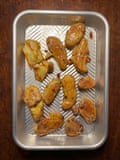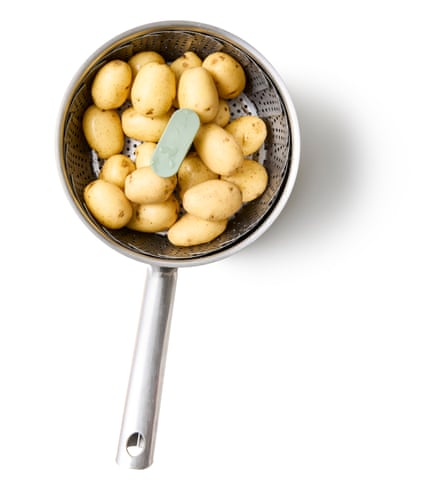When I pitched the idea for today’s column, my editor’s response was underwhelming to say the least. “Is that even a recipe?” he asked, which is exactly the attitude that inspired me in the first place. Often the simplest dishes feel in the least need of an actual recipe, yet surely I can’t be alone in thinking that the leathery, greasy roast new potatoes that turn up so often on tables at this time of year show some room for improvement.
I used to be of Jane Grigson’s opinion that “new potatoes should either be steamed or put into boiling water with sprigs of mint” – after all, they’re so good, and their season so short, from April to August, why meddle with perfection? But, having recently enjoyed crisp-skinned, buttery- fleshed beauties from a restaurant oven, I’d like to add them to my repertoire, too. While anyone can roast a potato, doing it proper justice clearly requires a little more thought.
The potatoes
New potatoes are, as the name suggests, the first of the early potatoes to crop each year – the ones with the thin, papery skins that can be rubbed off with a fingernail. The first and smallest of these are, I think, still better steamed and buttered or oiled; there’s not really enough skin on them to crisp, but the slightly larger, more robust ones that follow are admirably suited to this endeavour, which seems only to intensify their slightly nutty flavour.

Though the term “new” refers only to freshly dug potatoes of any early variety, those sold as such in this country tend also to be waxy, with a high moisture and a low starch content. Their dense, smooth flesh is ideal for salads and boiling, because it retains its shape after cooking, but they’re no good for fluffy mash or baked potatoes. Jersey royals tend to be the earliest in the shops each year, thanks to the island’s milder climate, but you can use anything that’s labelled salad potatoes – anya, la ratte, charlotte, epicure – for the recipe below.
Don’t bother to peel them (if they’re really fresh, they should come unwashed, and you can just rinse off the dirt and rub off any sorry-looking bits of skin); not only will the skin crisp up pleasingly, but I think it contains much of the tuber’s flavour (in this, and perhaps this only, I dare to disagree with the great Simon Hopkinson, who writes in Week In Week Out, “there truly is nothing worse than a new potato cooked with its skin intact. Just go away all of you who say: ‘but all the goodness and vitamins of a potato lie just beneath its skin!’ This does not mean you have to leave it there to get to it”). Do, however, make sure they’re all roughly the same size, because that will ensure they cook evenly. (Cutting a few in half is fine, if necessary, but I prefer to leave them whole – they look prettier, and I think the texture is better, especially if you’re going to boil them.)
The preparation

Most recipes I try call for the potatoes to be pre-cooked to some degree, much as one would for ordinary roast potatoes. J Kenji López-Alt, Mary Cadogan and Nigel Slater all boil theirs: López-Alt for five minutes (but from cold) until “the exteriors are tender”, Cadogan for 10, which counts as a kind of par-boil, and Slater “until tender” all the way through. López-Alt writes on Serious Eats: “Papery crusts occur when the layer of gelatinised starches that crisp up on the exterior of the potato isn’t thick enough. As the potato comes out of the oven and sits, steam from its core penetrates the crust, softening it from the inside out. Parboiling the potatoes will help build up this layer of starch.”
Nigella Lawson steams hers until tender instead, which she suggests should take 20-30 minutes, though I find the baby new potatoes she specifies are done in half that time. They also taste more satisfyingly potatoey than the boiled versions, something I put down to the fact that they’re lost none of their flavour to the water.
Delia Smith and David Tanis, meanwhile, both roast their potatoes from raw, though Smith marinates them in oil, vinegar and aromatics for a couple of hours beforehand. On balance, I agree with Slater that “they need a few minutes in boiling water before they hit the oven if they are not to toughen as they roast” – my testers and I find Smith’s spuds chewy rather than crisp (no good can surely come of contradicting two of my culinary heroes in one column, but I’m duty bound to report my findings). Tanis’s are much better, for reasons I shall go into later, but for a simple roast spud, pre-cooking seems the safest bet.

López-Alt, like Smith, adds vinegar, in his case to the water when boiling, to “allow the starch to gelatinise while keeping the potatoes relatively firm and intact”, on the basis that “pectin, the glue that holds vegetable cells together, doesn’t break down very readily in acidic environments”. While I’m sure he’s right, the likelihood of potatoes breaking down after five minutes in boiling water feels vanishingly slim – and, in any case, I’m going to steam mine. (If this is impractical, put them in a pan of cold, salted water and boil until just tender instead.)
To smash or bash?
López-Alt adopts a technique familiar to me from standard roast potatoes, treating the parboiled spuds a bit rough by “bashing them around a bit until their exteriors are coated in a film of bashed-up potato bits [which] allows you to crisp up not just the cut surfaces, but the skins as well”. Leaving aside the fact that after just five minutes of boiling, I have to shake that pan like a woman possessed to have any effect on its occupants, I find a simpler, and more effective, method is simply to crush each potato lightly, as Cadogan, Lawson and Slater recommend, “to break the skin and flesh a little in order to allow the oil to penetrate and the potato to crisp”, to quote the last in Tender. Because they all react slightly differently to being squashed, this produces a pleasing variety of shapes to crisp up in as many different ways, from crunchy crags of flesh to thin, almost potato crisp-like shards of skin. Plus, tiny squashed potatoes also look rather comical to my mind.

The temperature
Cadogan roasts the potatoes at 200C (180C fan)/390F/gas 6 for 20 minutes, and Slater for twice that time, while Lawson cranks up the oven by fully 20 degrees and sits them in the middle for half an hour. López-Alt and Smith, mavericks both, turn up the oven to 260C, or “the highest setting” (which, coincidentally, is 260C), and bake them, in Lopez-Alt’s case, for 55 minutes, though I have to whip mine out after half an hour, because they’re already bordering on the burnt. They have a decent crunchy crust, as promised, but for me it’s too thick and dominant in flavour, in marked contrast with those baked at a lower temperature, which have a more delicate, shattering crispness and still taste predominantly of potato flesh, rather than its sweet, browned skin. A more moderate heat allows them time to acquire a rich, golden tan without drying out.

Tanis isn’t seeking crispness with his “steam-roasted” new potatoes for the New York Times, which are baked in a greaseproof paper parcel with aromatics, making them deliciously soft and rich in flavour – a slightly more luxe take on the standard steamed spud that would be perfect for a dinner party, perhaps paired with poached fish or asparagus.
I’ve eschewed any extras that might overpower the subtle flavour of the main ingredient, but as well as using different fats for different effects, you might like to bake your potatoes with chopped rosemary (Slater), smoked paprika (Cadogan for BBC Good Food) or garlic, rosemary, sage and thyme (Smith and Tanis). López-Alt adds shallots towards the end of the cooking, then, after they come out of the oven, sloshes it all with oil, garlic, chives, parsley and lemon zest. Meanwhile, Lawson finishes hers with a “wincing hit” of vinegar, which cuts through the creamy texture of the potatoes and oil beautifully. Personally, however, I think they’re delicious just as they are – these are lucky to make it to the table in my house.

(The problem with very simple recipes such as this is that there often aren’t many variables, so I must acknowledge that my perfect version is very similar to Nigella Lawson’s version in At My Table, but with a slightly shorter cooking time. After all, if it ain’t broke …)
Prep 5 min
Cook 45 min
Serves 2-4
500g small new potatoes
1-2 tbsp olive oil, or neutral oil or animal fat
Salt
Try to find potatoes that are all roughly the same size, so you can keep all their skins intact while steaming; if any really are whoppers, though, then cut them in half.

Steam until just tender all the way through, or about 15 minutes for baby potatoes. (Alternatively, put the potatoes in a pan just large enough to hold them all, cover with cold water, salt well, bring to a boil, then simmer until just cooked through. Drain and return to the hot pan to steam-dry before roasting.)
Meanwhile, heat the oven and a roasting tin, filled with only just enough oil to coat the base (how much will, of course, depend on the size of your tin), to 200C (180C fan)/390F/gas 6.

Put the steamed potatoes on a board and lightly crush each one with a fork, spoon or potato masher, but only just so you hear the skins split, and not so hard that they break apart (though, if a few do, such is life).

Remove the hot tin from the oven. If you can, set it on a low heat on the hob to keep the fat warm while you roll each potato in turn in the hot oil to coat. Spread out the potatoes as much as possible, then season generously with salt.

Roast for 20 minutes, or until richly golden brown underneath (larger potatoes may take longer), then flip and bake for another 10 minutes. Serve immediately.
-
New potatoes: is roasting sacrilege to you, or am I teaching my grandmother to suck eggs here? Do you prefer them dark and crunchy, or lightly golden and gently crisp? And what do you serve them with? (Plant-based suggestions particularly welcome!)

 23 hours ago
6
23 hours ago
6













































